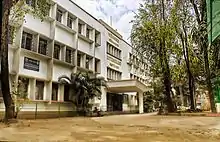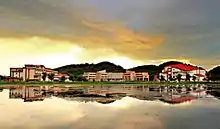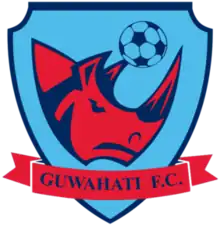Guwahati
Guwahati (/ɡʊwɑːˈhɑːti/, Assamese: [ˈɡʊwaɦati]; formerly known as Gauhati) is the largest city in the Indian state of Assam and also the largest metropolis in northeastern India. A major riverine port city along with hills, and one of the fastest growing cities in India, Guwahati is situated on the south bank of the Brahmaputra.[13] It is called the 'Gateway to North East India'.[14][15]
Guwahati
Gauhati Pragjyotishpur | |
|---|---|
 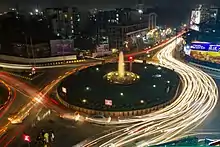 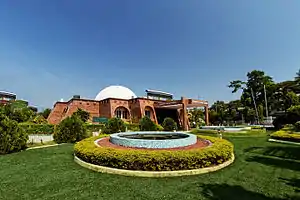 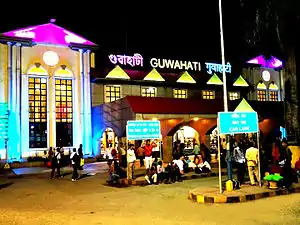 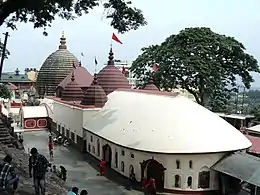 From top, left-to-right: Guwahati Aerial View, Guwahati Club Area, Guwahati Planetarium, Guwahati railway station, Kamakhya Temple | |
| Nicknames: | |
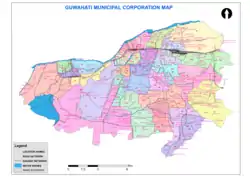 Guwahati Metropolis Map | |
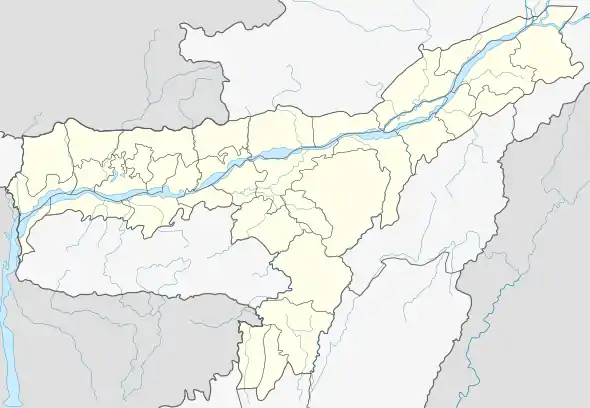 Guwahati Map of Assam  Guwahati Guwahati (India) | |
| Coordinates: 26°10′20″N 91°44′45″E | |
| Country | |
| State | Assam |
| Region | Lower Assam |
| District | Kamrup Metropolitan district |
| Government | |
| • Type | Mayor-council |
| • Body | Guwahati Municipal Corporation |
| • Mayor | Mrigen Sarania (BJP) |
| • Deputy Commissioner | Biswajit Pegu, IAS[3] |
| • Police Commissioner | Munna Prasad Gupta, IPS[4] |
| Area | |
| • Metropolis | 262 km2 (101 sq mi) |
| • Metro | 1,528 km2 (590 sq mi) |
| Elevation | 50−680 m (164−2,231 ft) |
| Population | |
| • Metropolis | 1,116,267 |
| • Rank | 47th |
| • Density | 4,300/km2 (11,000/sq mi) |
| Demonym(s) | Guwahatian |
| Time zone | UTC+5:30 (IST) |
| PIN | 781 0XX |
| Telephone code | +91 - (0) 361 - XX XX XXX |
| ISO 3166 code | IN-AS |
| Vehicle registration | AS-01 (Kamrup Metro) / AS-25 (Kamrup Rural and Dispur) |
| HDI | |
| Sex ratio | 940 ♀/ 1000 ♂ |
| City animal | Gangetic river Dolphin[11] |
| Climate | Cwa |
| Precipitation | 2,054 millimetres (80.9 in) |
| Official language | Assamese |
| Literacy | |
| Website | www |
The ancient cities of Pragjyotishpura and Durjaya (North Guwahati) were the capitals of the ancient state of Kamarupa.[16] Many ancient Hindu temples like the Kamakhya Temple, Ugratara Temple, Basistha Temple, Doulgovinda and the Umananda Temple are situated in the city, giving it the title of "The City of Temples".[17] Dispur, the capital of Assam, is in the circuit city region located within Guwahati and is the seat of the Government of Assam.
Guwahati lies between the banks of the Brahmaputra River and the foothills of the Shillong plateau, with LGB International Airport to the west and the town of Narengi to the east. The North Guwahati area, to the northern bank of the Brahmaputra, is being gradually incorporated into the city limits. The noted Madan Kamdev is situated 30 kilometers (19 miles) from Guwahati. The Guwahati Municipal Corporation, the city's local government, administers an area of 216 square kilometres (83 sq mi),[5] while the Guwahati Metropolitan Development Authority (GMDA) is the planning and development body of Greater Guwahati Metropolitan Area.[7] Guwahati is the largest city in Northeast India.[6]
The Guwahati region hosts diverse wildlife including rare animals such as Asian elephants, pythons, tigers, rhinoceros, gaurs, primate species, and endangered birds.[18][19]
Etymology
Once known as 'Pragjyotishpura' (the light of the east), Guwahati derives its name from the Assamese words "Guva" derived from the Sanskrit word Guvaka, meaning areca nut and its plant and "Hati" meaning market,[20] the market of areca nut.
History
Ancient history
Guwahati's myths and history go back several thousands of years. Although the exact date of the city's beginning is unknown, references in the epics, Puranas, and other traditional histories of India, lead many to assume that it is one of the ancient cities of Asia. Epigraphic sources place the capital of Kamarupa kingdom in Guwahati.[21] The Kalika Purana mention that Kamarupa was inhabited by Kiratas.[22] Located within Guwahati is the ancient Shakti temple of Goddess Kamakhya in Nilachal hill (an important seat of Tantric and Vajrayana Buddhism), the ancient and unique astrological temple Navagraha in Chitrachal Hill, and archaeological remains in Basistha and other archaeological locations of mythological importance.[23]
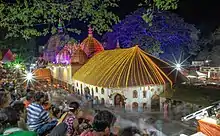
The Ambari[24] excavations trace the time period of the city of Guwahati between the 2nd century BCE and the 1st century CE, in the Shunga-Kushana period of Indian history. During earlier periods of the city's history it was known as Pragjyotishpura, and was the capital of Assam under the Kamarupa kingdom. Descriptions by Xuanzang (Hiuen Tsang) reveal that during the reign of the Varman king Bhaskaravarman (7th century CE), the city stretched for about 30 li (15 km or 9.3 mi).[25] Archaeological evidence by excavations in Ambari, and excavated brick walls and houses discovered during construction of the present Cotton College's auditorium suggest the city was of economic and strategic importance until the 9th–11th century CE.[26]
Medieval history
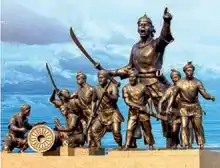
Forces of Muhammad bin Bakhtiyar Khalji suffered a disastrous defeat in the hands of Raja Prithu in Kamrup during Tibetan expedition. The entire army of Bakhtiyar Khalji was defeated by native forces, which forced him to retreat.
The city was the seat of the Borphukan, the civil-military authority of the Lower Assam region appointed by the Ahom kings. The Borphukan's residence was in the present Fancy Bazar area, and his council-hall, called Dopdar, was about 300 yards (270 m) to the west of the Bharalu stream. The Majindar Baruah, the personal secretary of the Borphukan, had his residence in the present-day deputy commissioner's residence.[27]
The Mughals invaded Assam seventeen times, but were defeated by the Ahoms in the Battle of Itakhuli and the Battle of Saraighat in outskirts of Guwahati.There was an ancient boatyard in Dighalipukhuri, probably used by the Ahoms in medieval times.[28] Medieval constructions include temples, ramparts, and other structures in the city.[29][30]
Modern history
In 1972, the capital of Assam was moved to Dispur, a neighbourhood in Guwahati.
Urban morphology
Guwahati's 'urban form' radiates from a central core with growth corridors radiating and extending towards the south, east, and west. In the past few decades, southern Guwahati areas such as Ganeshguri, Beltola, Hatigaon, Six Mile, and Panjabari began forming a southern sub-center surrounding the capital complex at Dispur. The core area[31] consists of the old city with Pan Bazaar, Paltan Bazaar, Fancy Bazaar and Uzan Bazaar, with each area facilitating unique urban activities.[13][32]

Among the city corridors, the most important is the corridor formed along the Guwahati-Shillong (GS) Road towards the south (almost 15 km [9.3 mi] from the city-center). The GS Road corridor is an important commercial area with retail, wholesale and commercial offices developed along the main road; it is also a densely built residential area in the inner parts. The capital complex of Assam at Dispur is situated in this corridor. This corridor has facilitated the growth of a southern city sub-center at Ganeshguri, along with other residential areas to the south developed during the past few decades.[13][32]
The corridor extending towards the west (around 30 km [19 mi] from the city-center) contains a rail-road linking not only Guwahati but also other parts of the northeastern region east of Guwahati to western Assam and the rest of India. The corridor links residential and historically important areas such as Nilachal Hill (Kamakhya), Pandu, and Maligaon (headquarters of Northeast Frontier Railways) before it separates into two – one towards North Guwahati via the Saraighat Bridge and the other continuing west towards LGB International Airport via Gauhati University (Jalukbari). There are also many river ports/jetties along this corridor.[13][32]
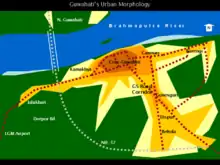
The third major corridor extends towards the east (around 15 km [9.3 mi] from the city-center) linking Noonmati (Guwahati Refinery) and Narengi, and has facilitated residential growth along with it. Highway NH-37, which encircles the city's southern parts and links the southern corridor in Noumile to the western corridor in Jalukbari is currently supporting rapid development. Similarly, the VIP Road linking Zoo Road with the eastern corridor and recently completed Hengerabari-Narengi Road are also supporting massive residential development to the east.[13][32]
Guwahati is one among 98 Indian cities proposed to become Smart Cities under a project embarked on by Ministry of Urban Development, Government of India.[33][34]
Geography
The Brahmaputra river flows to the north of the metropolis. The city is bordered on the south by the foothills of the Shillong plateau and to the east by the Amchang Wildlife Sanctuary. The Bharalu River, a tributary of the Brahmaputra, flows right through the heart of the city. To the south-west of the city lies Dipor Bil, a permanent freshwater lake with no prominent inflows apart from monsoon run-off from the hills that lie to the south of the lake. The lake drains into the Brahmaputra, 5 km (3.1 mi) to the north, and acts as a natural stormwater reservoir for the city.[35][36] There are also multiple hills within the city limits.

Climate
Guwahati has a humid subtropical climate (Köppen climate classification Cwa), falling just short of a tropical savanna climate (Köppen climate classification Aw).[37]
| Month | Jan | Feb | Mar | Apr | May | Jun | Jul | Aug | Sep | Oct | Nov | Dec | Year |
|---|---|---|---|---|---|---|---|---|---|---|---|---|---|
| Record high °C (°F) | 29.6 (85.3) |
35.7 (96.3) |
38.6 (101.5) |
40.1 (104.2) |
40.3 (104.5) |
38.5 (101.3) |
37.5 (99.5) |
38.0 (100.4) |
37.8 (100.0) |
37.0 (98.6) |
33.0 (91.4) |
30.9 (87.6) |
40.3 (104.5) |
| Average high °C (°F) | 23.6 (74.5) |
26.3 (79.3) |
29.8 (85.6) |
30.6 (87.1) |
31.4 (88.5) |
32.2 (90.0) |
32.1 (89.8) |
32.6 (90.7) |
31.8 (89.2) |
30.6 (87.1) |
28.0 (82.4) |
24.9 (76.8) |
29.5 (85.1) |
| Daily mean °C (°F) | 17.3 (63.1) |
19.8 (67.6) |
23.1 (73.6) |
25.4 (77.7) |
27.0 (80.6) |
28.7 (83.7) |
29.0 (84.2) |
29.2 (84.6) |
28.4 (83.1) |
26.4 (79.5) |
22.7 (72.9) |
18.7 (65.7) |
24.6 (76.3) |
| Average low °C (°F) | 11.0 (51.8) |
12.8 (55.0) |
16.4 (61.5) |
20.3 (68.5) |
22.9 (73.2) |
25.2 (77.4) |
25.8 (78.4) |
25.8 (78.4) |
24.9 (76.8) |
22.3 (72.1) |
17.3 (63.1) |
12.5 (54.5) |
19.8 (67.6) |
| Record low °C (°F) | 3.0 (37.4) |
5.3 (41.5) |
8.5 (47.3) |
10.3 (50.5) |
16.4 (61.5) |
20.4 (68.7) |
21.6 (70.9) |
22.3 (72.1) |
19.9 (67.8) |
13.8 (56.8) |
10.0 (50.0) |
4.9 (40.8) |
3.0 (37.4) |
| Average rainfall mm (inches) | 12.0 (0.47) |
22.3 (0.88) |
58.4 (2.30) |
187.8 (7.39) |
243.1 (9.57) |
295.0 (11.61) |
326.2 (12.84) |
265.7 (10.46) |
197.8 (7.79) |
121.3 (4.78) |
16.0 (0.63) |
6.2 (0.24) |
1,751.8 (68.97) |
| Average rainy days | 1.2 | 2.3 | 4.7 | 10.3 | 13.3 | 14.7 | 16.1 | 12.9 | 9.7 | 5.0 | 1.0 | 0.6 | 91.9 |
| Average relative humidity (%) (at 17:30 IST) | 70 | 56 | 50 | 62 | 70 | 77 | 80 | 80 | 81 | 79 | 77 | 76 | 72 |
| Mean monthly sunshine hours | 225.5 | 213.8 | 220.1 | 200.6 | 191.1 | 133.1 | 123.7 | 161.6 | 139.0 | 205.8 | 230.9 | 231.7 | 2,276.9 |
| Source 1: India Meteorological Department[38][39][40] | |||||||||||||
| Source 2: NOAA (sun 1971–1990),[41] Tokyo Climate Center (mean temperatures 1981–2010)[42] | |||||||||||||
Infrastructure
The city has a comparatively high quality of life. A 2006 survey ranked Guwahati 17th among all the large and medium-sized Indian cities.[43] The city provides competitive residential and working environments with beautiful landscapes, pleasant climate, modern shopping areas, modern apartments, and bungalows, and considerably developed social infrastructure. A centrally funded four-lane, ambitious East-West Corridor will pass through Guwahati and connect all the state capitals of Northeast India. Completion of the project will boost the vital upliftment of the whole region.[13]
The city still needs attention to improve its infrastructure. Funding from the Asian Development Bank is providing assistance to improve Guwahati's transportation infrastructure along with a substantial amount from Jawaharlal Nehru National Urban Renewal Mission (JNNURM) for its development.[13]
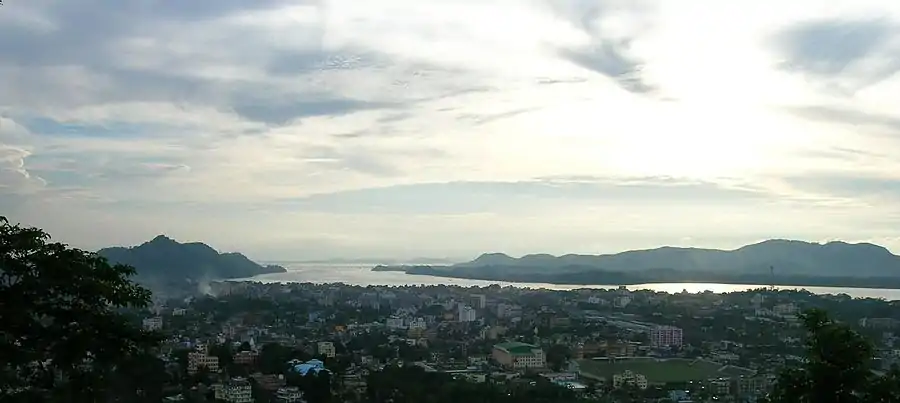
Administration and Governance
Dispur, the capital of Assam, lies in Guwahati. The passing of the North Eastern (Reorganization Areas) Act in 1971 by the Indian Parliament accorded Meghalaya the status of a full-fledged state. After the creation of Meghalaya as a separate state, Shillong continued to be the joint capital of both Assam and Meghalaya. However, in 1972, the Government of Assam decided to shift the capital to Dispur. Accordingly, the first sitting of the Budget Session of the Assam Legislative Assembly was held at Dispur on 16 March 1973.[44] Dispur houses the Secretariat of Assam Government, the Assam Assembly House, the National Bank for Agriculture and Rural Development (NABARD) Regional Office, the North Eastern Development Finance Corporation Ltd (NEDFi) House and the Guwahati Tea Auction Centre (GTAC).[45]
Guwahati Municipal Corporation is the local body responsible for governing, developing and managing the city. It is divided into 31 municipal wards.[46] Guwahati Metropolitan Development Authority (GMDA) is an agency responsible for planning and development of the greater Guwahati Metropolitan Area and for revising the Guwahati Master Plan and Building Bylaws to cover an area of 3,214 square kilometres (1,241 sq mi) by 2025.[47]
Guwahati consists of four assembly constituencies: Jalukbari, Dispur, Gauhati East and Gauhati West,[48] all of which are part of Gauhati (Lok Sabha constituency).[49]
Police
Guwahati is the headquarters of Assam Police.
The city is under the Police Commissionerate of Guwahati headed by the Commissioner of Police, Guwahati. It is divided into three districts: East Police District, Central Police District, and West Police District, each headed by a Deputy Commissioner of Police. Each police district consists of officers, not below the rank of Assistant Commissioner of Police, functioning as executive magistrates within a said metropolitan area.[50]
Judiciary
Guwahati is the principal seat of the Gauhati High Court. It acts as the High Court of Assam and also of Nagaland, Mizoram and Arunachal Pradesh with their outlying benches of Kohima, Aizawl and Itanagar, respectively. Gauhati High Court came in effect from 5 April 1948. It initially had its sittings at Shillong but was shifted to Gauhati from 14 August 1948.[51]
Guwahati also houses the Court of the District and Sessions Judge, Kamrup established in 1920. It is a lower court of the district judiciary having territorial jurisdiction over the greater Guwahati area only.[52]
Problems
- Increase in population
Guwahati has seen a rapid rise in population in the past few years. People from other parts of the state and the region routinely migrate to the city chiefly for education and occupation resulting in undesirable expansion of population in the city, which further brings with it many collateral problems in the city.[53] It is expected that the population of the city will rise to 1.5 Million by 2035 which is estimated at 1.1 Million in 2020 [54]
- Price rise
One of the economic problems that the citizens of Guwahati have to put up with is the hike in prices of many essentials, chiefly vegetables, poultry, and fish. The prices of these commodities keep escalating at an inordinate rate because of which the buyers find it difficult to buy these items. Vegetables are transported into Assam from West Bengal, Bihar, Uttar Pradesh, Delhi, Maharashtra and Meghalaya and the truckers en route have to pay considerable amount of money as tax at various check posts.[55][56] It is one of the causes of rise in prices of vegetables in the markets of Guwahati. The prices of locally available vegetables and fruits undergo large markup because of transportation expenses grounds, besides intra-State check posts taxes. In addition to these, the wholesale dealers, as well as the retail sellers, augment the prices of the commodities according to their own desires.
The price of poultry, mainly chicken, that reaches the city markets from places like Chaygaon and Barpeta have been soaring rapidly because of similar factors. There has been steep rise in the price of fish as well, the prominent varieties of which being Rohu ("Rou"), Catla ("Bahu"), Walking catfish ("Magur") and Monopterus ("Kuchia") among many others.[57][58]
Demographics
Population
| Religion | Population |
|---|---|
| Hindu | 815,499 |
| Muslim | 119,825 |
| Christian | 8,913 |
| Sikh | 3,449 |
| Buddhist | 1,495 |
| Jain | 9,193 |
| Others | 3,960 |
Guwahati is one of the fastest growing cities in India.[13] Guwahati has a population of 957,352 as of the 2011 census. Population of Guwahati in 2021 is estimated to be 11 lakhs (approx).[60][61] It is estimated that Guwahati metro will house 2.8 million residents by 2025.[62] Below Graph shows Population of Guwahati (1950-2040):[63]-
Literacy and sex ratio
The percentage of the child population of Guwahati is 9.40%. The average literacy rate is stated to be 91.47% with male literacy at 94.24% and female literacy at 88.50%. The sex ratio has been recorded to be 933 females per 1000 males and child sex ratio to be 940 girls per 1000 boys.[64]
Languages
According to the 2011 census, there were around 957,352 people living in Guwahati city, of which around 558,532 population spoke Assamese, 198,544 speaks Bengali, 138,056 speaks Hindi, 16,331 speaks Bodo and 4.81% speaks other minority languages like Manipuri, Nepali, Telugu, Punjabi and others.[65]
Education
Guwahati is the major educational hub of Northeast India.[66] Among the esteemed institutions is the Indian Institute of Technology Guwahati (IIT), an autonomous institute dedicated in the field of technical studies in India. Cotton University, erstwhile Cotton College is yet another century-old institution in the fields of Science and Arts.
Guwahati has numerous educational institutes such as Gauhati University, Cotton University, Srimanta Sankaradeva University of Health Sciences, Assam Science and Technology University, Gauhati Commerce College, K.C. Das Commerce College, Handique Girls College, Indian Institute of Technology, Guwahati, Indian Institute of Information Technology, Guwahati, B. Borooah College, Dispur College, Regional Dental College, Guwahati, N.E.F Law College, National Law University and Judicial Academy, Gauhati Medical College and Hospital, Assam Engineering College, Assam Institute of Management, Assam Don Bosco University, Assam Down Town University, Royal Global University, Lakshmibai National Institute of Physical Education NE Regional Centre, Tata Institute of Social Sciences, Guwahati Campus and Krishna Kanta Handiqui State Open University, National Institute of Pharmaceutical Education and Research, Guwahati, Institute of Advanced Study in Science and Technology, and ICAR-National Research Centre on Pig.
There are various Private Schools and colleges too. Like Delhi Public School, Sanskriti the Gurukul and Holy Child School.
Economy
Pandu, located on the banks of the Brahmaputra at the western part of the city, is an ancient urban area that acted as the chief military base for the Ahoms against external invasions. Due to extensive fortification ('Gorh') surrounding Pandu, it acts as a natural river harbor and is formally called Gar-Pandu. Pandu port falls under Dhubri-Sadiya National Waterway-2 and is an important terminal cum transit point for goods and cargo as well as passenger and tourist vessels. Construction of both low-level and high-level jetty of fixed terminal, capable of handling container vessels, has been completed and has further enhanced revenue generation for the city.[67][68]

The manufacturing sector in Guwahati contributes a substantial share to the economy of the city. Petroleum manufacturing is an important economic activity in the city. The Guwahati Refinery is the most important manufacturing industry in the city. Located at Noonmati, the refinery was set up by the Indian Oil Corporation Limited as the first public sector refinery of India as well as the refinery of Indian Oil since 1962. It was built with an initial crude processing capacity of 0.75 million tonnes per year at the time of its commission which was gradually increased to 1.0 million tonnes per year. It produces various products and supplies them to the other northeast states and also beyond to Siliguri through the Guwahati-Siliguri pipeline. The various products produced by the refinery include Liquefied Petroleum Gas (LPG), Kerosene Oil, Turbine Fuel (aviation use), Motor Spirit, High-Speed Motor Diesel, Light Diesel Oil, and Raw Petroleum Coke. There is also an LPG bottling plant in the city.[69][70]
Tea manufacturing and processing is another important activity of Guwahati. Assam is one of the highest tea-producing areas in the world, contributing 80% of India's export and 55% of the country's total tea production. So high is the production of tea in Assam that it is the biggest industry of the state. The headquarters of the Assam Branch Indian Tea Association (ABITA) is located at Guwahati. The Guwahati Tea Auction Centre (GTAC), located adjacent to the capital complex at Dispur, is the world's largest CTC tea auction center and the second largest in terms of total tea auctioned. The inaugural sale took place on 25 September 1970 and the first lot of tea was auctioned at the price of Rs. 42.50 which, during those days, was a big achievement. In the month of August 2019, a kilogram of Maijan Orthodox Golden tea sold for a record-setting price of Rs 70,501 at the Guwahati Tea Auction Centre.[71]
Many centralised, private and international banks have set up their branches in the city with the Reserve Bank of India having one of its own at Pan Bazaar.[72][73][74]
Transport
Air
Guwahati is served by the Lokpriya Gopinath Bordoloi International Airport, in Borjhar, about 20 kilometres (12 mi) west from the heart of the city. With all major domestic and international airlines flying into Guwahati, it is the eleventh busiest airport in India in total passenger traffic. Daily and weekly flights are available to Delhi, Mumbai, Kolkata, Chennai, Visakhapatnam, Bengaluru, Hyderabad, Ahmedabad, Lucknow, Jaipur, Kochi, Bangkok, Paro, Kathmandu,
Rail

The city of Guwahati and the northeastern region falls under the Northeast Frontier Railway (NFR) Zone of the Indian Railways, the headquarters of which is in Maligaon, near Nilachal Hills, in the northwest of the city. The Guwahati railway station, located in Paltan Bazaar area of Guwahati, is the major railway station of the city. It lies along the Barauni-Guwahati Line and Guwahati–Lumding section, categorised as an A-1 railway station under Lumding railway division.
There are four more railway stations in the city – the Kamakhya Junction for passenger and freight services, the New Guwahati railway station (near Noonmati) for only freight services, Narangi railway station and Azara railway station. There are regular trains connecting Guwahati to and from other major cities of the country. Rajdhani Express, Poorvottar Sampark Kranti Express, Brahmaputra Mail, Kamrup Express, Northeast Express, Saraighat Express and Garib Rath are some significant trains running to and from Guwahati. The train with the longest route in India, Vivek Express, which runs from Dibrugarh in Upper Assam to Kanyakumari in the southern tip of India passes through Guwahati.[75]
Road

The length of surfaced roads within the city is 218 km (135 mi). National Highway 27 connects Guwahati with the states West Bengal, Bihar and rest of India. This highway connects Guwahati with Silchar in Barak Valley Assam and further connecting the city to the states of Meghalaya, Manipur, Mizoram and Tripura. National Highway 17 from Sevoke in West Bengal terminates in Jalukbari and connects Guwahati with the major cities of Dhubri and Cooch Behar. National Highway 15 and its several secondary roads runs through both the banks of River Brahmaputra and connects the Guwahati with the cities of Tezpur, Jorhat, Dibrugarh in Upper Assam and the states of Arunachal Pradesh and Nagaland.[76]
Public transportation is well developed in the city. Buses are the major means of public transport in Guwahati. The state-owned Assam State Urban Transport Corporation, a subsidiary of Assam State Transport Corporation (ASTC) and private operators provide the city bus services within the city. ASTC also operates the Volvo air-conditioned bus services within the city as well as to the LGBI airport. In addition to this, there are a number of private bus operators that regularly run day and night bus services from Guwahati to neighbouring towns and cities within Assam and the other Northeastern States. Rupnath Brahma Inter-State Bus Terminus (ISBT), located at Betkuchi area on NH-37, is the most significant terminal cum transit point for buses plying between Guwahati and other destinations in Assam and Northeast India. The areas of Adabari and Paltan Bazaar also act as nodal points in providing bus services to towns and cities in Assam and adjoining states.[75][77]
A metro rail project has also been planned to relieve the hectic traffic conditions on the streets.[78][79]
Guwahati has also seen a rise in the usage of cycling as a mode of transport and as per some unofficial estimates, there was almost a 50% increase in the number of people who took up cycling in the wake of COVID-19.[80] The city has an active cycling community and is amongst the few Indian cities that has a Bicycle Mayor and a Junior Bicycle Mayor.[81]
Water
The Inland Water Transport Department is headquartered at Pandu port in Guwahati. The waterways transportation services in Guwahati are used for transporting bulk goods and cargo, and for movement of passenger and tourist vessels. Ferry services are available for transportation of people from different ports along the Brahmaputra to Pandu port.[75]
Sports
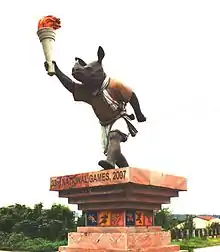
Guwahati features the multi-purpose Nehru Stadium which hosts mainly cricket and football; while the Kanaklata Indoor Stadium in the R.G. Baruah Sports Complex (in the Ulubari locality) is one of the oldest sports complex in the city.[82] The North-East Frontier Railway Stadium of Maligaon, the Sports Authority of India (SAI) complex of Paltan Bazaar and the Judges Field are other prominent sporting venues of the city.
The sporting infrastructures specially constructed for the 33rd National Games in 2007 include a large stadium at Sarusajai—the Indira Gandhi Athletic Stadium, the Dr. Zakir Hussain Aquatic Complex, and the Karmabir Nabin Chandra Bordoloi A.C. Indoor Hall. Other new sports structures include the Maulana Md. Tayabullah Hockey Stadium at Bhetapara, the Deshbhakta Tarun Ram Phookan Indoor Stadium at Ulubari, Rajiv Gandhi Indoor Stadium at Amingaon, Chachal Tennis Complex and Tepesia Sports Complex.[83] The renovated sports complexes include Ganesh Mandir Indoor Stadium at Khanapara, Rudra Singha Sports Complex at Dispur and Gauhati University Sports Stadium. The Indira Gandhi Athletic Stadium was also the main venue of the 2016 South Asian Games, which was held from 5 to 16 February 2016. The stadium also hosted the Himalayan Region Games in 2017 and the FIFA U-17 World Cup in India in 2017. It will also host the FIFA U-17 Women's World Cup in India in 2020 including the opening match.
Guwahati is home to the professional football team NorthEast United FC of Indian Super League,[84] who play their home matches at the Indira Gandhi Athletic Stadium. It presents one of the finest football atmospheres in India.
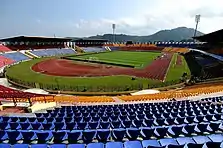
ACA Stadium, also known as Bhupen Hazarika Stadium, a cricket stadium located at Barsapara is the home of Assam cricket team.[85] It has a seating capacity of 40,000. It is the largest cricket stadium in Northeast India and 2nd largest in East India. It hosted an India vs Australia T20 match in 2017 in its international debut. The first ODI in the stadium was held in 2018 between India and West Indies.
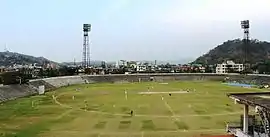
| Club | Sport | League | Stadium | Logo | ||
|---|---|---|---|---|---|---|
| NorthEast United FC | Football | Indian Super League | Indira Gandhi Athletic Stadium |
| ||
| Northeastern Warriors | Badminton | Premier Badminton League | Karmabir Nabin Chandra Bordoloi Indoor Stadium | |||
| Guwahati F.C. | Football | I-League 2nd Division | Nehru Stadium, North-East Frontier Railway Stadium |
| ||
| ASEB SC | Football | GSA Super League | Nehru Stadium | |||
| Gauhati Town Club | Football | GSA Super League, Youth League U18 | Judges Field | |||
| FC Green Valley | Football | GSA Super League, Assam State Premier League | Nehru Stadium | |||
| Assam Titans Futsal Club | Futsal | North East Futsal League | Karmabir Nabin Chandra Bordoloi Indoor Stadium | |||
| Assam Rhino Football Club | Football | North East Futsal League | Frolic Sports Arena | |||
Media & telecommunications
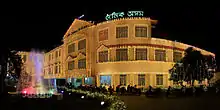
Assamese daily newspapers published from the city are Dainik Agradoot, Asomiya Pratidin, Asomiya Khobor, Amar Asom, Dainik Janambhumi, Janasadharan, Niyomiya Barta, Dainik Asam, Dainandin Barta and Gana Adhikar. English dailies are The Assam Tribune, The Sentinel, The Telegraph, The Times of India and Eastern Chronicle. Eclectic Northeast Magazine[86] is a leading Guwahati-based monthly Northeast magazine with an online version. G Plus is the only English weekly tabloid published from Guwahati.[87]
Doordarshan Kendra Guwahati provides composite satellite television services to Northeast India. The Guwahati-based 24-hour regional news channels include News Live, DY 365, Pratidin Time, Prag News, Assam Talks and News 18 Assam/North-East.
The Guwahati Radio Station of state-owned All India Radio was inaugurated on 1 July 1948 as Shillong-Guwahati Station.[88] The Headquarter of the Shillong-Guwahati Station was shifted from Shillong to Guwahati in 1953.[88] It is a full-fledged Regional broadcasting station with 3 channels; the Guwahati A & B Channels are AM Channels and the CBS Channel is a FM Channel. The other FM stations include 92.7 BIG FM, Radio Gup-Shup 94.3 FM, Red FM 93.5 and Radio Mirchi. Telecom services are BSNL, Airtel, Vodafone, Idea Cellular and Jio.
Notable Places of Worship
 Kamakhya Temple
Kamakhya Temple Bhubaneswari Temple, Kamakhya
Bhubaneswari Temple, Kamakhya
Notable people

- Nabakanta Barua, Poet/Academician
- Bhaskaravarman, ruler of Kamarupa
- Siddhartha Bhattacharya, Politician
- Barsha Rani Bishaya, Assamese film actor
- Utpal Das, Assamese film actor
- Arunima Dutta, Yoga teacher
- Zubeen Garg, Singer
- Arnab Goswami, Journalist
- Mamoni Raisom Goswami, Novelist/Academician
- Durgabar Kayastha, Medieval literateur
- Angarag Mahanta, Singer/Composer
- Abu Nechim, Cricketer
- Nayyara Noor, Singer
- Riyan Parag, Cricketer
- Maitrayee Patar, Singer & poet
- Pushyavarman, founder of Kamrup Kingdom
- Bhabendra Nath Saikia, Novelist, short story writer and Film Director
- Himanta Biswa Sarma, Politician
- Shiva Thapa, Boxer and Olympian
See also
- Assam State Museum
- Brahmaputra Valley Film Festival
- Battle of Saraighat
- Gauhati High Court
- History of Beltola
- Kamrup
- List of people from Assam
- List of colleges affiliated to Gauhati University
- List of educational institutions in Guwahati
- Personalities from Western Assam
- Pragjyotishpura
- Pragjyotisha Kingdom
- Saraighat Bridge
- Silasindurighopa
- Tourism in North East India
- Varman dynasty
References
- "An insider's guide to Guwahati: more than just a gateway to India's northeast". The Guardian. Archived from the original on 4 October 2015. Retrieved 5 October 2015.
- "Kamrup Metro District". Kamrup(M) District Administration. Archived from the original on 11 September 2015. Retrieved 5 October 2015.
- "Chief Minister of Assam - Deputy Commissioners". Archived from the original on 10 May 2018. Retrieved 10 May 2018.
- "Police Commissionerate Guwahati". Guwahati City Police. Archived from the original on 6 September 2015. Retrieved 15 September 2015.
- "Guwahati City".
- "Magisterial powers for Guwahati top cop". The Telegraph. Archived from the original on 30 September 2015. Retrieved 15 September 2015.
- "GMDA".
- "Population of Guwahati 2020 (Demographic, Facts, Etc) – India Population 2020".
- "Guwahati City Census". censusindia.gov.in. Archived from the original on 23 September 2015. Retrieved 15 September 2015.
- "Archived copy" (PDF). Archived (PDF) from the original on 22 March 2017. Retrieved 26 January 2018.CS1 maint: archived copy as title (link)
- "Gangetic river dolphin to be city animal of Guwahati". The Times of India. 6 June 2017. Archived from the original on 24 September 2017. Retrieved 14 June 2017.
- "Guwahati City Census 2011 data". Census2011.co.in. Archived from the original on 23 September 2015. Retrieved 22 September 2014.
- "Capital of Assam". Assam Online Portal. Archived from the original on 7 August 2015. Retrieved 31 August 2015.
- "Guwahati a gateway to the exotic North East". Mumbai Mirror. 27 November 2011. Retrieved 10 June 2020.
- Bhushan, Chandra (2005). Assam: Its Heritage and Culture. Kalpaz Publications. p. 182. ISBN 978-8178353524.
- "History". Government of Assam. Archived from the original on 21 May 2013. Retrieved 14 June 2012.
- "About Guwahati". guwahationline.in. Archived from the original on 16 October 2015. Retrieved 17 October 2015.
- Choudhury, A.U. (2002). Big cats, elephant, rhino and gaur in Guwahati. The Rhino Found. NE India Newsletter 4:16-19.
- Choudhury, A.U. (2003). Guwahati: the city of Adjutants and other endangered birds. The Rhino Found. NE India Newsletter 5:14-17.
- Sharma, Mukunda Madhava (1978). Inscriptions of Ancient Assam. Department of Publication, Gauhati University. p. 137.
It is also significant that the capital city of Pragjyotisa has derived its modern name Gauhati (As. Guva̅ha̅ti) from market place of ta̅mbu̅la tree. Guva̅ ( = skt. guva̅ka= ta̅mbu̅la)+ha̅ti̅ ( = rows).
- (Gait 1906:13–15)
- (Shin 2019:320) According to the Kalika Pura1Ja, 'that country [Kamarupa], inhabited by the strong, cruel and foolish Kirata people, was kept concealed by Siva in the past for using as his own province' (Shastri 1992: chapter 38, 101)
- "Guwahati". guwahatitimes.com. Archived from the original on 8 December 2015. Retrieved 9 November 2015.
- "Civilisation existed in Guwahati between 2nd, 1st century BC". The Assam Tribune. 22 January 2016. Archived from the original on 27 January 2016. Retrieved 27 January 2016.
- "Assam in the eyes of Hiuen Tsang". enajori.com. Archived from the original on 12 August 2015. Retrieved 18 September 2015.
- "History". Assam Online Portal. Archived from the original on 2 October 2015. Retrieved 18 September 2015.
- Baruah 1993, pp. 200–201.
- "Guwahati". guwahatitimes.com. Archived from the original on 8 December 2015. Retrieved 9 November 2015.
- Reporter, Staff (11 May 2009). "Ambari excavation site reveals age of Guwahati". The Assam Tribune. Guwahati. Archived from the original on 4 October 2013. Retrieved 12 June 2012.
- Saikh Md Sabah Al-Ahmed. "The Tales of Ponds". The Assam Tribune. Guwahati. Archived from the original on 19 January 2012. Retrieved 12 June 2012.
- TI Trade. "Assam Tribune online". Assamtribune.com. Archived from the original on 22 February 2011. Retrieved 12 February 2013.
- "Guwahati's Urban Morphology". Assam Online Portal. Archived from the original on 1 October 2015. Retrieved 31 August 2015.
- "Guwahati among 7 NE Smart Cities". The Assam Tribune. 28 August 2015. Archived from the original on 31 August 2015. Retrieved 29 August 2015.
- "Smart City full list". The Financial Express. 28 August 2015. Archived from the original on 29 August 2015. Retrieved 29 August 2015.
- "Geography of Guwahati". Guwahati Online Portal. Archived from the original on 17 October 2015. Retrieved 15 September 2015.
- "Geographical Profile of Guwahati". Maharashtra Web Portal. Archived from the original on 18 January 2007. Retrieved 15 September 2015.
- Peel, M. C.; Finlayson, B. L.; McMahon, T. A. (2007). "Updated world map of the Köppen–Geiger climate classification" (PDF). Hydrology and Earth System Sciences. 11 (5): 1633–1644. doi:10.5194/hess-11-1633-2007. ISSN 1027-5606. Archived (PDF) from the original on 3 February 2012. Retrieved 16 September 2016.
- "Station: Gauhati (A) (Bhorjar) Climatological Table 1981–2010" (PDF). Climatological Normals 1981–2010. India Meteorological Department. January 2015. pp. 283–284. Archived from the original (PDF) on 5 February 2020. Retrieved 6 February 2020.
- "Extremes of Temperature & Rainfall for Indian Stations (Up to 2012)" (PDF). India Meteorological Department. December 2016. p. M26. Archived from the original (PDF) on 5 February 2020. Retrieved 6 February 2020.
- "Guwahati Climatological Table 1981–2010". India Meteorological Department. Retrieved 6 February 2020.
- "Guwahati Climate Normals 1971–1990". National Oceanic and Atmospheric Administration. Retrieved 20 April 2015.
- "Normals Data: Guwahati - India Latitude: 26.10°N Longitude: 91.58°E Height: 54 (m)". Japan Meteorological Agency. Archived from the original on 29 February 2020. Retrieved 29 February 2020.
- "Urban Matrix: India's Top 50 Cities Ranked on Quality of Life". Outlook Money. Archived from the original on 24 September 2015. Retrieved 15 September 2015.
- "Assam Legislative Assembly - History". assamassembly.gov.in. Archived from the original on 19 September 2015. Retrieved 10 November 2015.
- "Dispur Map". Maps of India. Archived from the original on 12 September 2015. Retrieved 16 September 2015.
- "New Guwahati Municipal Corporation". Archived from the original on 31 August 2014. Retrieved 15 September 2015.
- "GMDA Master Plan". The Times of India. Archived from the original on 2 January 2017. Retrieved 15 September 2015.
- "Map of Assembly constituencies, Assam". Maps of India. Archived from the original on 22 March 2011. Retrieved 2 April 2011.
- "List of Parliamentary & Assembly Constituencies" (PDF). Assam. Election Commission of India. Archived from the original (PDF) on 4 May 2006. Retrieved 5 October 2008.
- "Guwahati gets police commissioner". The Times of India. Archived from the original on 6 June 2015. Retrieved 16 September 2015.
- "Gauhati High Court". Gauhati High Court. Archived from the original on 13 September 2015. Retrieved 16 September 2015.
- "Kamrup Metro District Judiciary". Kamrup Metro District Judiciary. Archived from the original on 8 December 2015. Retrieved 16 September 2015.
- "Problems of Guwahati". assamtribune.com. 6 March 2015. Archived from the original on 3 February 2015. Retrieved 2 February 2015.
- https://populationstat.com/india/gauhati
- "Increasing prices of potato causing concern". The Assam Tribune. 28 April 2014. Archived from the original on 23 September 2015. Retrieved 21 August 2015.
- "Govt yet to initiate action to check price rise". The Assam Tribune. 6 May 2013. Archived from the original on 23 September 2015. Retrieved 21 August 2015.
- "Abnormal rise in prices of foodstuff hits citizens". The Assam Tribune. 30 June 2013. Archived from the original on 23 September 2015. Retrieved 21 August 2015.
- "Rise in chicken, fish prices affects locals". The Times of India. 1 July 2013. Retrieved 21 August 2015.
- www.census2011.co.in › metropolitan Web results Guwahati Metropolitan Urban Region Population 2011-2021
- https://www.findeasy.in/population-of-guwahati/
- https://www.macrotrends.net/cities/21261/gauhati/population
- "Masterplan for Guwahati" (PDF). GMDA. Archived from the original (PDF) on 30 June 2016. Retrieved 15 September 2016.
- https://worldpopulationreview.com/world-cities/guwahati-population/
- "Guwahati city population census 2011". census 2011. Archived from the original on 23 September 2015. Retrieved 24 October 2015.
- "C-16 Population By Mother Tongue - Guwahati". censusindia.gov.in. Retrieved 16 August 2020.
- "Education". assam.gov.in. Archived from the original on 29 July 2017. Retrieved 28 July 2017.
- "National Waterway-2". India-WRIS. Archived from the original on 17 November 2015. Retrieved 7 November 2015.
- "Pandu-the river port". guwahati.com. 7 November 2015. Archived from the original on 17 November 2015. Retrieved 7 November 2015.
- "Guwahati Refinery". guwahationline.in. 6 November 2015. Archived from the original on 8 December 2015. Retrieved 6 November 2015.
- "Indian Oil". www.iocl.com. Retrieved 21 September 2019.
- Kalita, Prabin (1 August 2019). "Assam's Maijan tea fetches Rs 70,000 for a kilo, breaks record". The Times of India. Retrieved 21 September 2019.
- "Business and Economy of Guwahati". GuwahatiOnline. Archived from the original on 2 September 2018. Retrieved 31 August 2015.
- "Economy". Assam Online Portal. 6 November 2015. Archived from the original on 1 October 2015. Retrieved 6 November 2015.
- "Reserve Bank of India, Guwahati Profile". Archived from the original on 8 October 2017.
- "Public Transport in Guwahati". guwahationline.in. 17 October 2015. Archived from the original on 17 October 2015. Retrieved 17 October 2015.
- "How To Reach Guwahati". guwahatitimes.com. 9 November 2015. Archived from the original on 8 December 2015. Retrieved 9 November 2015.
- "Guwahati to have AC city buses". Assam Times. 17 October 2015. Archived from the original on 8 December 2015. Retrieved 17 October 2015.
- "Guwahati to get metro rail and feeder Bus Rapid Transit System - The Economic Times". Economictimes.indiatimes.com. 11 January 2013. Archived from the original on 10 May 2013. Retrieved 12 February 2013.
- Johnson, Marc (22 January 2013). "Assam Government discusses Guwahati metro proposal - Rail News from". rail.co. Archived from the original on 19 February 2013. Retrieved 12 February 2013.
- Aug 20, TNN /; 2020; Ist, 15:32. "Online drive in city for cycling to stay fit and break chain of virus | Guwahati News - Times of India". The Times of India. Retrieved 6 October 2020.CS1 maint: numeric names: authors list (link)
- Das, Amlan Jyoti. "Guwahati among 95 cities to register for 'India Cycles 4 Change Challenge'". EastMojo. Retrieved 6 October 2020.
- "Sports". assam.gov.in. Archived from the original on 29 July 2017. Retrieved 28 July 2017.
- "33rd National Games Guwahati 2007- India's Biggest Extravaganza". batchmates.com. Archived from the original on 23 September 2016. Retrieved 2 February 2015.
- "Indian Super League-Northeast United FC". indiansuperleague.com. Archived from the original on 12 September 2016. Retrieved 15 September 2016.
- "KKR eyes ACA stadium at Barsapara as one of its home grounds". telegraphindia.com. Archived from the original on 18 September 2016. Retrieved 15 September 2016.
- "Eclectic NorthEast". Archived from the original on 7 April 2019. Retrieved 23 April 2019.
- Gupta, Devesh (3 January 2014). "Weekly tabloid G Plus launched in Guwahati". afaqs.com. Archived from the original on 28 February 2018. Retrieved 28 February 2018.
- "Brief History of All India Radio, Guwahati". Archived from the original on 10 August 2017. Retrieved 28 July 2017.
Bibliography
- Shin, Jae-Eun (2018), "Region Formed and Imagined: Reconsidering temporal, spatial and social context of Kamarupa", in Dzüvichü, Lipokmar; Baruah, Manjeet (eds.), Modern Practices in North East India: History, Culture, Representation, London & New York: Routledge, pp. 23–55
- Barua, Rai Bahadur Kanak Lal (1933). Early History of Kāmarupa: From the Earliest Times to the End of the Sixteenth Century. The Author.
- Baruah, Swarna Lata (1993). Last Days of Ahom Monarchy: A History of Assam from 1769 to 1826. Munshiram Manoharlal Publishers Pvt. Limited. ISBN 978-81-215-0462-1.
- Gait, Sir Edward Albert (1906). A History of Assam. Thacker, Spink & Company.
- Shin, Jae-Eun (2019). Redefining Divine Presence: A Study of Hidden Lingas in the Mid-Brahmaputra Valley. Primus Books. p. 313–334.
External links
| Wikimedia Commons has media related to Guwahati. |
| Wikiquote has quotations related to: Guwahati |
 Guwahati travel guide from Wikivoyage
Guwahati travel guide from Wikivoyage- The Government of Assam
- The District of Kamrup
- Guwahati at the Encyclopædia Britannica
